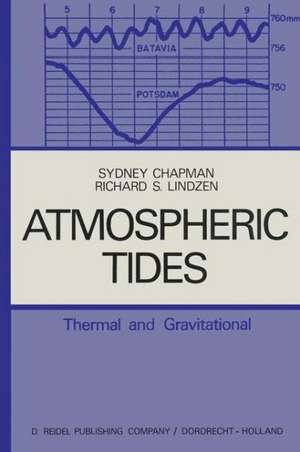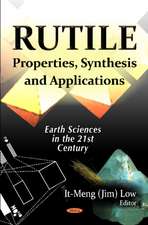Atmospheric Tides: Thermal and Gravitational
Autor S. Chapman, R.S. Lindzenen Limba Engleză Paperback – 14 oct 2011
Preț: 724.50 lei
Preț vechi: 883.53 lei
-18% Nou
Puncte Express: 1087
Preț estimativ în valută:
138.63€ • 144.74$ • 114.74£
138.63€ • 144.74$ • 114.74£
Carte tipărită la comandă
Livrare economică 05-19 aprilie
Preluare comenzi: 021 569.72.76
Specificații
ISBN-13: 9789401034012
ISBN-10: 940103401X
Pagini: 216
Ilustrații: IX, 200 p.
Dimensiuni: 160 x 240 x 11 mm
Greutate: 0.35 kg
Ediția:1970
Editura: SPRINGER NETHERLANDS
Colecția Springer
Locul publicării:Dordrecht, Netherlands
ISBN-10: 940103401X
Pagini: 216
Ilustrații: IX, 200 p.
Dimensiuni: 160 x 240 x 11 mm
Greutate: 0.35 kg
Ediția:1970
Editura: SPRINGER NETHERLANDS
Colecția Springer
Locul publicării:Dordrecht, Netherlands
Public țintă
ResearchCuprins
1. Introductory and Historical.- 1.1. Introduction: Pytheas, Bacon, Newton and Laplace.- 1.2. The Barometric and Other Daily Variations.- 1.3. Thermal Tides and Kelvin’s Resonance Theory.- 1.4. More Realistic Atmospheric Models.- 1.5. The Phase of S2 (p).- 1.6. Doubts as to the Resonance Theory.- 1.7. Renewed Hope in the Resonance Theory.- 1.8. Atmospheric Oscillations as Studied by Weekes and Wilkes.- 1.9. Rockets Exclude Resonance.- 1.10. Ozone Absorption of Radiation the Main Cause of S2(p).- 1.11. Upper Air Data.- 1.12. Theoretical Calculations of the Diurnal Thermal Tide.- 1.13. Other Features of Atmospheric Oscillations.- 2S. The Solar Daily Atmospheric Oscillations As Revealed By Meteorological Data.- 2S.1. The Material Studied; Ground Level Data.- 2S.2. Harmonic Analysis of S; The Non-Cyclic Variation.- 2S.3. The Seasonal Variation of S.- 2S.4. The World-Wide Distribution of S, Particularly of S(p).- 2S.5. The Daily Variation of Air Temperature T.- 2S.6. The Daily Wind Variation S(V).- 2S.7. Atmospheric Daily Changes above Ground Level.- 2L. The Lunar Atmospheric Tide As Revealed By Meteorological Data.- 2L.1. Introduction.- 2L.2. The Tropical Lunar Air Tide.- 2L.3. The Lunar Air Tide Outside the Tropics.- 2L.4. The Month and the Lunar Day.- 2L.5. Methods of Computation of L from Observed Data; Early Methods Based on Apparent Lunar Time.- 2L.6. The Chapman-Miller (or C-M) Method for Meteorological Variables.- 2L.7. Vector Probable Errors.- 2L.8. The Determination of L2 from Only a Few Meteorological Readings per Day.- 2L.9. The Lunar Semidiurnal Barometric Tide L2 (p).- 2L.10. The Expression of L2 (p) in Spherical Harmonic Functions.- 2L. 11. The Asymmetry of L2 (p) Relative to the Equator, and its Seasonal Variation.- 2L.12. Comparison of L2(p) and S2(p).-2L.13. The Lunar Tidal Wind Variation.- 2L.14. The Lunar Tidal Variation of Air Temperature.- 2L.15. The Lunar Tidal Changes of Height of Various Pressure Levels.- 2L.16. Brief Mention of the Lunar Geomagnetic Tide.- 3. Quantitative Theory Of Atmospheric Tides And Thermal Tides.- 3.1. Introduction.- 3.2. Equations.- 3.3. Methods of Solution.- 3.4. Sources of Excitation.- 3.5. Explicit Solutions.- 3.6. Shortcomings of Present Calculations.- 3.7. Comparison of Theory with Data.- List of Symbols for Chapter 3.- Guide To The Figures And Tables.- References.- Index Of Names.- Index Of Subjects.- Index Of Places.














